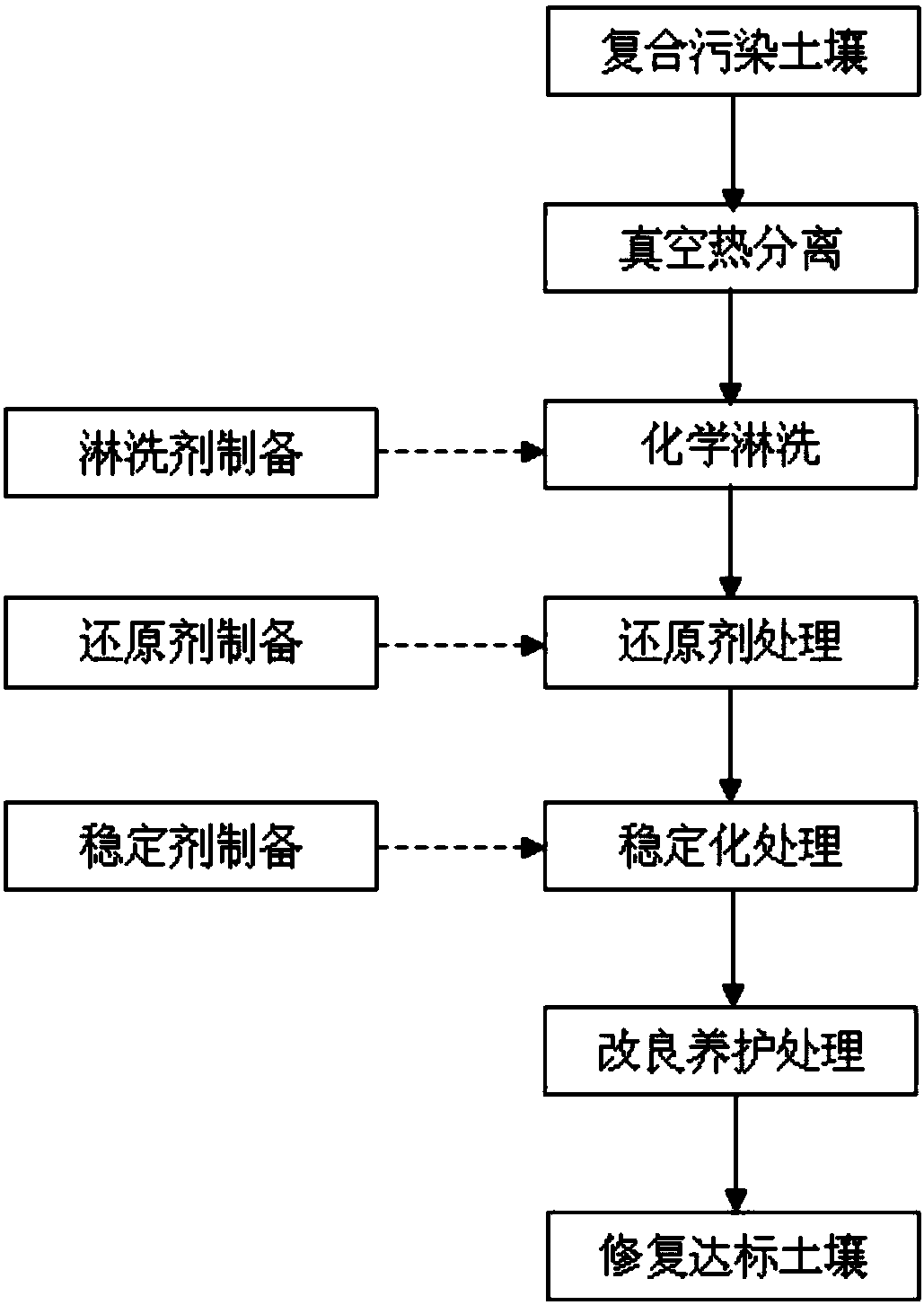A method for remediation of volatile organic compounds and heavy metal chromium composite polluted soil
A volatile organic compound and compound pollution technology, applied in the field of soil pollution remediation, can solve the problems of low remediation efficiency, high treatment cost, incomplete removal, etc., and achieve the effects of improving physical properties, high reduction performance, and shortening treatment time.
- Summary
- Abstract
- Description
- Claims
- Application Information
AI Technical Summary
Problems solved by technology
Method used
Image
Examples
Embodiment 1
[0023] Embodiment 1: Get 10kg of halogenated hydrocarbon and chromium compound polluted soil, carry out pH value, halogenated hydrocarbon content and total chromium content detection; The soil of polluted plot is dug out, is processed into the soil particle of 1-15mm by crusher; Then put the soil particles into a closed reactor, vacuumize to keep the pressure of the reactor at 20kpa, control the temperature of the reactor at 160°C by external heating, and process for 20 minutes, and carry out vacuum thermal separation to remove volatile halogens in the soil Then add solid powder polyacrylamide into the prepared 3% dilute acetic acid solution according to the ratio of 10g / L to form a mixed aqueous solution of acetic acid and polyacrylamide; put the soil after vacuum thermal separation into the water In the washing container, add the mixed aqueous solution of acetic acid and polyacrylamide to the soil in an amount of 1L / kg while stirring, and perform circular leaching for 10 minu...
Embodiment 2
[0024] Embodiment 2: Take 10kg of halogenated hydrocarbon and chromium composite polluted soil, and carry out the detection of pH value, halogenated hydrocarbon content and total chromium content; dig out the soil of the polluted plot, and process it into 1-15mm soil particles by a crusher; Then put the soil particles into a closed reactor, vacuumize to keep the pressure of the reactor at 20kpa, control the temperature of the reactor at 180°C by external heating, and process for 30min, and carry out vacuum thermal separation to remove volatile halogens in the soil Hydrocarbons; then according to the ratio of 10g / L, solid powder polyacrylamide is added to the prepared 3% dilute acetic acid solution to form a mixed aqueous solution of acetic acid and polyacrylamide; the soil after vacuum thermal separation is placed in the rinse In the container, add the mixed aqueous solution of acetic acid and polyacrylamide to the soil in an amount of 1L / kg while stirring, and perform circular...
Embodiment 3
[0025]Embodiment 3: Take 10kg of halogenated hydrocarbon and chromium compound polluted soil, carry out the detection of pH value, halogenated hydrocarbon content and total chromium content; dig out the soil of the polluted plot, and process it into 1-15mm soil particles by crusher; Then put the soil particles into a closed reactor, vacuumize to keep the pressure of the reactor at 20kpa, control the temperature of the reactor at 160°C by external heating, and process for 10 minutes, and carry out vacuum thermal separation to remove volatile halogens in the soil Hydrocarbons; then according to the ratio of 10g / L, solid powder polyacrylamide is added to the prepared 3% dilute acetic acid solution to form a mixed aqueous solution of acetic acid and polyacrylamide; In the washing container, add the mixed aqueous solution of acetic acid and polyacrylamide to the soil in an amount of 1L / kg while stirring, and carry out circular leaching for 20 minutes; collect the eluent for reductio...
PUM
 Login to View More
Login to View More Abstract
Description
Claims
Application Information
 Login to View More
Login to View More - R&D
- Intellectual Property
- Life Sciences
- Materials
- Tech Scout
- Unparalleled Data Quality
- Higher Quality Content
- 60% Fewer Hallucinations
Browse by: Latest US Patents, China's latest patents, Technical Efficacy Thesaurus, Application Domain, Technology Topic, Popular Technical Reports.
© 2025 PatSnap. All rights reserved.Legal|Privacy policy|Modern Slavery Act Transparency Statement|Sitemap|About US| Contact US: help@patsnap.com


